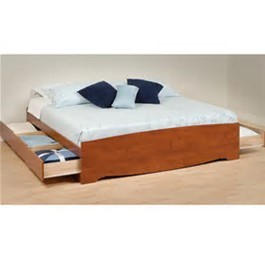The trick to finding the right mattress is to look for one that does at least the following:
- Gently compresses when the weight and curvature of your body presses against it. While at the same time the mattress needs to push evenly (no pressure points) against every portion of your body that touches the mattress. If your body has a bulge (hips, butt, shoulders, etc.), as the bulge presses against the mattress, the mattress needs to compress to make room for the bulge without pressing any harder on that bulge than it does on a non-bulge area.
- Motion separation – The motion of one person on the bed should cause little or no movement of another person on the bed.
- Temperature neutrality – The mattress surface should raise to your body temperature but not accumulate heat (sleep hot) or lose heat (sleep cold) throughout the sleep period.
- Edge support – Sleeping near the edge of the bed should not make you feel you are falling off.
- Ease of entry and exit – Is it easy to lay down on and to get off the mattress.

Here are a couple things to keep in mind about mattresses.
- Your body weight distributes over the area of mattress. You might weigh several hundred pounds but an area the size of your handprint will need to support less than a pound or two. If you want to test a mattress by pressing on it with your hand, press relatively lightly. Pressing hard is not a realistic test
- To maintain proper alignment the mattress only needs to compress an inch or two (depending on your weight). Good alignment translates to a mattress on the firmer side of the scale. The diagrams and posed pictures they use to demonstrate mattress compression exaggerates the amount of compression needed. Look at the pictures of regular people laying on a mattress; they barely make a dent. Sore necks, backs, legs, etc. are about proper alignment, which is about some but not too much compression around your bulges.
- A comfortable bed is about even support (lack of pressure points) and temperature neutrality. A good mattress does not have pressure points even when you shift positions. If you need to sleep in an exact position to be comfortable (absent a medical condition), your mattress does not support you evenly.
Spoiler alert. Foam mattresses have evolved and now meet the above requirements better than innerspring and air bladder mattresses do.
The nature of springs, stiffer when compressed, will always cause pressure points when you change positions. They can mitigate the problem with all sorts of tricks but in the end, they have pressure points and foam mattresses do not. Putting springs under the foam pads is a gimmick that actually reduces the life of the foam that you actually sleep on. Air bladder mattresses have the selling point that partners of different sizes / preferences can have a different firmness. Foam mattresses do not need a mechanical system to accommodate the preferences of two people on a bed. Besides, readjusting ones position on an air bladder mattress changes the pressure in the bladder and causes pressure points but changing position on a foam mattress does not cause a pressure point.
Foam has the magic property of not getting firmer as you compress it (except, of course, if you compress it to the limit). This same property means motion separation and edge support is inherent to a foam mattress.
Closed cell foam tends to sleep hot. The air in the cells heats up from your body heat over time. Open cell foam allows the air to flow through the foam. Thus, open cell foam tends to be temperature neutral (not sleep hot or cold). Open-cell foam tends to be too soft to provide proper body alignment. Natural latex foam or an open-cell synthetic that mimics natural latex foam provides temperature neutrality and the latex is stiff enough to provide proper alignment. Latex foam is firm enough to push down against when you try to get on or off the mattress. In addition, it is springy enough to give your rear-end a little push as you stand up.
I sleep on a 100% natural latex foam mattress from Ikea. My spouse and I like it a lot. I do not hesitate to recommend a 100% latex mattress. Having said that, there are other options, which can be less expensive and probably very close to as good. Several manufacturers make a mattress with several layers of different foam, the top couple of inches, of which, is an open-cell foam. By layering different foam densities these mattresses can get a slightly different feel. I have read more reviews on these mattresses than I care to admit. I have not tried any of them except the 100% natural Ikea mattress but they all seem to get similar high ratings. Most of the reviews say whatever mattress they are reviewing is better than an innerspring and air bladder mattress. However, they also say the foam mattresses in this category all perform about equally. They differentiate themselves instead by focusing on things like cost, warranties, customer service, return policies, and the like.
A foam mattress is mostly air. Which means, they can vacuum pack a queen-sized mattress and put it in a box about the size of a mini-refrigerator. Which means you can order them online and they can ship them to you via standard methods (UPS, FedEx, etc.) We went to the Ikea showroom several times to try out the mattress options. However, most foam mattresses are online purchases. The manufacturers generally offer a free return policy should you not like it. From what I understand, their return rates are generally less than 1%. The return rate for showroom bought innerspring and air bladder mattresses is much higher than that.

A couple final points to consider. A foam mattress is typically 8 to 10 inches thick. Thicker does not equal better in the foam mattress world. Foam mattresses lay on a firm surface, most often slats or a platform bed (right on the floor?). So put away the step stool to get into bed. However, think about new options when the mattress and box spring combination are not 2 feet thick. One thing getting more popular is a platform bed with storage (drawers) under the platform. You get storage without increase the footprint in the room and the mattress will still be at a reasonable height.
Conclusion
Foam technology has evolved over the past several years. An open-cell foam topped mattress or 100% latex mattress do what a good mattress is supposed to do, better than an innerspring or air bladder mattress. These foam mattresses are another example of a technology change that changes the basic assumptions (paradigm). A plain looking 10-inch foam mattress sleeps better than an 18 inch thick innerspring with an exotic looking pillow top. A plain looking foam offers more support than two air bladder mattresses in the same frame and separates motion just as well. There is a reason that so many are replacing their old fancy mattresses with new, simpler, more functional open-cell topped mattresses.
We donated our old mattress to Bridging. They put it to good use.

Appendix
Some of the more popular mattresses in this class
Reviewers
Best mattress for back pain – Choose Mattress
Best mattress for back pain – Sleep junkie